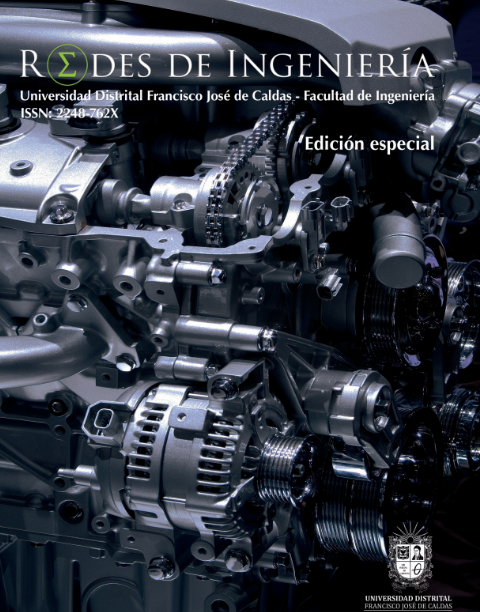DOI:
https://doi.org/10.14483/2248762X.12474Publicado:
2017-09-08Número:
Edición especial, Enero - Junio de 2017Sección:
InvestigaciónModelo para la simulación de sistemas de multi-agentes robóticos en Python
Descargas
Resumen (es)
En la etapa de diseño de Sistemas Multi-Agentes Robóticos, la validación de algoritmos y la verificación del modelo cinemático inverso y directo, es importante para la detección de problemas o errores antes de implementarlos en el agente físico. En este artículo se presenta el diseño de un modelo en Pyhton para la simulación de agentes robóticos de dos ruedas compuesto por sub sistemas de agentes, validando el modelo cinemático del agente robótico dentro de un laberinto.Referencias
H. Hu and D. Gu, “A Multi-Agent System for Cooperative Quadruped Walking Robots,” pp. 1–5, 2000.
H. Mintzberg, “STRUCTURE IN 5’S: A SYNTHESIS OF THE RESEARCH ON ORGANIZATION DESIGN,” Manag. Sci., vol. 26, no. 3, p. 322, 1980.
L. Ostrowski, M. Helfert, and S. Xie, “A Conceptual Framework to Construct an Artefact for Meta-Abstract Design Knowledge in Design Science Research,” 2012 45th Hawaii Int. Conf. Syst. Sci., pp. 4074–4081, 2012.
M. Kolp, P. Giorgini, and J. Mylopoulos, “Multi-agent architectures as organizational structures,” Auton. Agent. Multi. Agent. Syst., vol. 13, no. 1, pp. 3–25, 2006.
B. Innocenti, B. López, and J. Salvi, “A multi-agent architecture with cooperative fuzzy control for a mobile robot,” Robot. Auton. Syst. Robot. Auton. Syst. 50th Anniv. Artif. Intell. Campus Multidiscip. Percept. Intell., vol. 55, pp. 881–891, 2007.
A. Farinelli, G. Grisetti, and L. Iocchi, “Design and implementation of modular software for programming mobile robots,” Int. J. Adv. Robot. Syst., vol. 3, no. 1, pp. 037–042, 2006.
J.-A. Fernández-Madrigal, C. Galindo, J. González, E. Cruz-Martín, and A. Cruz-Martín, “A software engineering approach for the development of heterogeneous robotic applications,” Robot. Comput. Integr. Manuf., vol. 24, pp. 150–166, 2008.
F. Caballero, L. Merino, P. Gil, I. Maza, and A. Ollero, “A probabilistic framework for entire WSN localization using a mobile robot,” Rob. Auton. Syst., vol. 56, no. 10, pp. 798–806, Oct. 2008.
G. P. Sadrollah, J. C. Barca, A. I. Khan, J. Eliasson, and I. Senthooran, “A distributed framework for supporting 3D swarming applications,” in 2014 International Conference on Computer and Information Sciences (ICCOINS), 2014, pp. 1–5.
P. Shinners, “Pygame.” [Online]. Available: http://pygame.org/.
J. Rumbaugh, I. Jacobson, and G. Booch, The Unified Modeling Language Reference Manual. 2004.
J. Kwon, J. H. Kim, and J. Seo, “Consensus-based obstacle avoidance for robotic swarm system with behavior-based control scheme,” in 2014 14th International Conference on Control, Automation and Systems (ICCAS 2014), 2014, no. Iccas, pp. 751–755.
A. Jha and M. Kumar, “Two wheels differential type odometry for mobile robots,” Proc. - 2014 3rd Int. Conf. Reliab. Infocom Technol. Optim. Trends Futur. Dir. ICRITO 2014, 2015.
R. Siegwart, I. Nourbakhsh, and D. Scaramuzza, Introduction to Autonomous Mobile Robots, Second Edition, Second. The MIT Press, 2011.
C. Jung and W. Chung, “Accurate calibration of two wheel differential mobile robots by using experimental heading errors,” Proc. - IEEE Int. Conf. Robot. Autom., pp. 4533–4538, 2012.
C. Alippi and G. Vanini, “A RSSI-based and calibrated centrali zed localization technique for Wireless Sensor Networks,” Fourth Annu. IEEE Int. Conf. Pervasive Comput. Commun. Work., pp. 1–5, 2006.
E. Menegatti et al., “Autonomous discovery, localization and recognition of smart objects through WSN and image features,” 2010 IEEE Globecom Work. GC’10, pp. 1653–1657, 2010.
N. Zhou, X. Zhao, and M. Tan, “RSSI-based mobile robot navigation in grid-pattern wireless sensor network,” 2013 Chinese Autom. Congr., pp. 497–501, Nov. 2013.
J. Xiong, Q. Qin, and K. Zeng, “A Distance Measurement Wireless Localization Correction Algorithm Based on RSSI,” in 2014 Seventh International Symposium on Computational Intelligence and Design, 2014, no. 2, pp. 276–278.
J. Su, H. Huang, and C. Lee, “A simple and efficient diagonal maze-solver for micromouse contests and intelligent mobile robot education,” in The 26th Chinese Control and Decision Conference (2014 CCDC), 2014, pp. 2407–2411.
G. Parodi, A. Raska, M. Izquierdo, and E. Volentini, “Robot para resolución de laberintos,” in 2014 IEEE Biennial Congress of Argentina (ARGENCON), 2014, pp. 821–826.
A. C. Jimenéz, J. P. Anzola, and S. Bolaños, “Decentralized Model for Autonomous Robotic Systems Based on Wireless Sensor Networks,” ARPN J. Eng. Appl. Sci., vol. 11, no. 19, pp. 11378–11382, 2016.
H. John, D. Darren, F. Eric, and D. Michael, “Matplot.” [Online]. Available: http://matplotlib.org/.
Cómo citar
APA
ACM
ACS
ABNT
Chicago
Harvard
IEEE
MLA
Turabian
Vancouver
Descargar cita
Licencia
Reconocimiento – NoComercial – CompartirIgual (by-nc-sa): No se permite el uso comercial de la obra original, las obras derivadas deben circular con las mismas condiciones de esta licencia realizando la correcta atribución al autor.
Esta obra está bajo una licencia de Creative Commons Reconocimiento-NoComercial-CompartirIgual 4.0 Internacional













